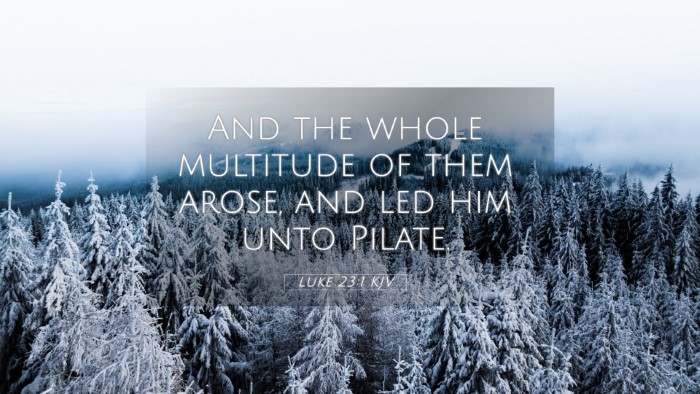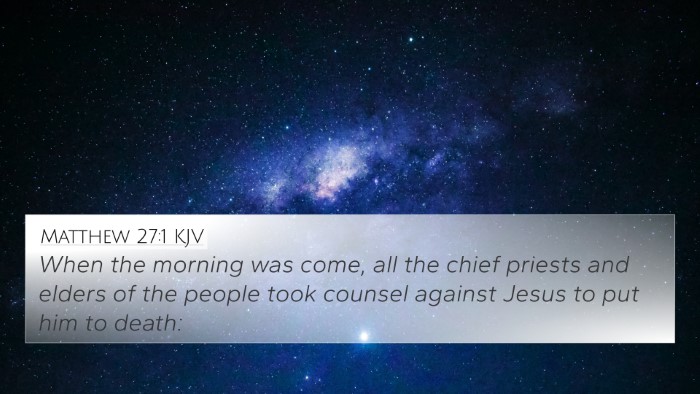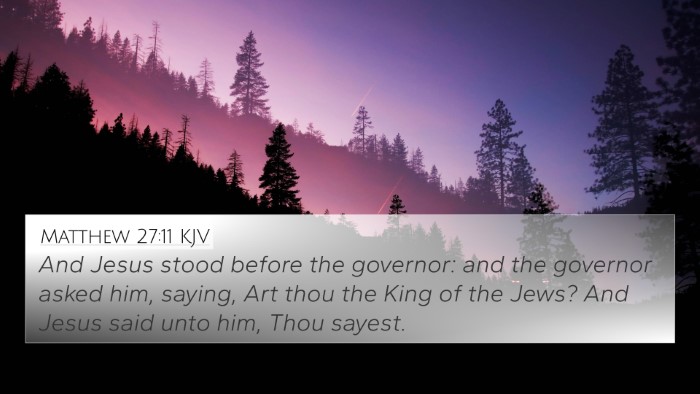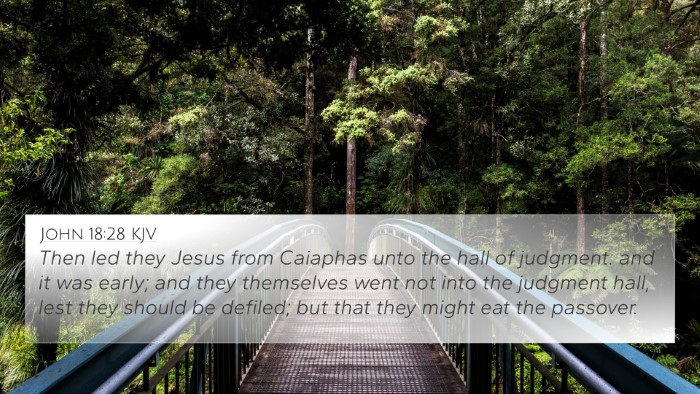Understanding Luke 23:1
Luke 23:1 states: “And the whole multitude of them arose, and led him unto Pilate.” This verse marks a significant moment in the passion narrative of Christ, reflecting both the historical and theological implications of Jesus’ trial before the Roman governor, Pontius Pilate.
Context and Overview
This verse occurs after the arrest of Jesus and serves as a narrative transition to the Roman trial phase. The leading of Jesus to Pilate encapsulates the culmination of the opposition against him by Jewish leaders, which sets the stage for the eventual crucifixion.
Commentary Insights
- Matthew Henry: Henry provides insight into the collective action of the multitude, emphasizing how public sentiment and the influence of leadership can lead to drastic decisions against an innocent person. He notes that the same people who praised Jesus as a miracle worker now rejected him.
- Albert Barnes: Barnes focuses on the shift of authority from Jewish leaders to Roman authorities. This transition indicates the fulfillment of prophetic scripture, where Jesus was to be handed over to the Gentiles, showcasing the sovereignty of God even in human injustice.
- Adam Clarke: Clarke elaborates on the motivations behind the multitude’s actions, suggesting that jealousy and fear of losing power fueled the hysteria against Jesus. He also highlights the irony of the situation, as the very crowd that welcomed Jesus in triumph now demands his execution.
Theological Implications
The action of leading Jesus to Pilate signifies the rejection of the Messiah by his own people—a theme explored throughout the New Testament. This moment also demonstrates the unfolding of divine providence, as the events pave the way for the overarching narrative of redemption through Christ’s sacrifice.
Bible Verse Cross-References
- Isaiah 53:3: Prophecy of the Messiah being despised and rejected.
- John 18:28-31: Description of the trial before Pilate and the rejection by the Jewish leaders.
- Matthew 27:1-2: Confirms that the chief priests and elders conspired against Jesus and delivered him to Pilate.
- Luke 22:66-71: The council of elders condemns Jesus before the trial with Pilate.
- Acts 3:14: Peter calls out the rejection of Jesus, linking to historical events surrounding his trial.
- Mark 15:1: This passage parallels Luke, confirming the multitude's actions leading Jesus to Pilate.
- John 19:16: Ultimately, Pilate hands Jesus over to be crucified, bringing fulfillment to the earlier verse.
- Psalms 118:22: The stone the builders rejected became the cornerstone, illustrating the fate of the Messiah.
- Acts 4:10-11: Apostles reaffirm the message of Jesus, whom the leaders rejected.
- Matthew 21:42: Jesus himself references the Psalm about the rejected stone, connecting to his own passion narrative.
Connections to Other Scripture
The connections between Luke 23:1 and the other verses highlight a consistent theme throughout Scripture: the unjust suffering of the righteous and the fulfillment of God’s plan through adversity.
Thematic Connections
Various thematic connections arise when considering Luke 23:1 in relation to other scriptures:
- Betrayal and Rejection: The series of verses surrounding Jesus' trial reflect a profound betrayal, present in John 13:18 where Jesus speaks of betrayal among his disciples.
- Suffering for Redemption: Though innocent, Jesus suffers unjustly, as foretold in 1 Peter 2:24, underscoring the theme of sacrificial love for humanity’s redemption.
- God's Sovereignty: God’s ultimate control over human events is a continuing theme seen in Proverbs 19:21, reminding believers that despite human decisions, divine purposes prevail.
- Prophecy Fulfillment: Multiple instances in the New Testament reaffirm how Jesus’ trial aligns with various prophecies regarding the Messiah, found in passages like Matthew 1:22-23.
Application for Believers
In studying Luke 23:1 along with its cross-references, believers can grasp deeper insights into the nature of sinful human actions juxtaposed with divine providence. This comprehension encourages a reflective lifestyle, reminding believers of the cost of discipleship.
Tools for Bible Cross-Referencing
To further understand the connections between Luke 23:1 and other Scriptures, using tools for Bible cross-referencing can be deeply beneficial. These tools facilitate:
- Identifying connections through a comprehensive Bible concordance.
- Utilizing a Bible cross-reference guide to enhance scriptural understanding.
- Engaging in cross-reference Bible study methods to explore intricate relationships between verses.
- Accessing Bible reference resources that enrich personal study time.
Conclusion
Luke 23:1 serves as a pivotal moment in the narrative of Jesus’ crucifixion. By employing comparative Bible verse analysis and exploring biblical verse parallels, one can uncover the richness of God’s redemptive plan—a plan that showcases the intertwining of human sinfulness with divine sovereignty.







